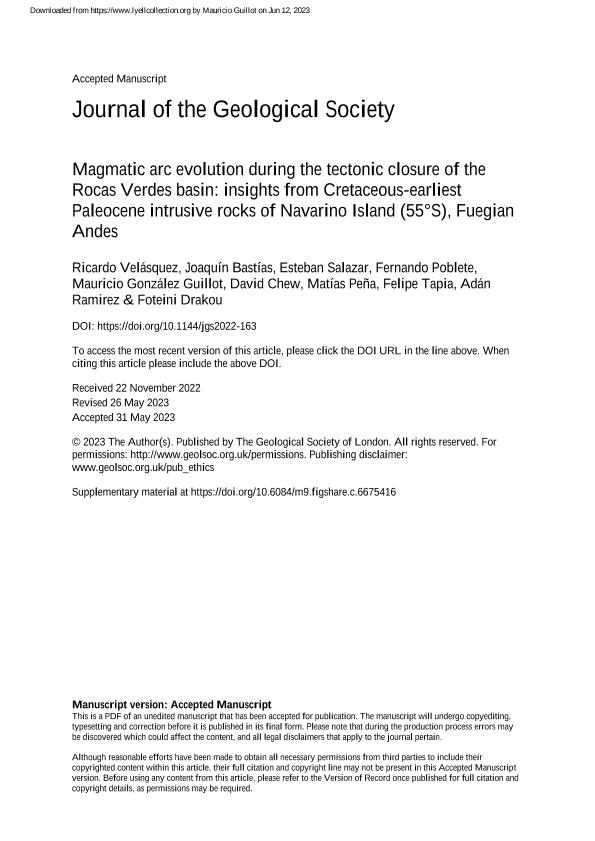Mostrar el registro sencillo del ítem
dc.contributor.author
Velásquez, Ricardo
dc.contributor.author
Bastías, Joaquín
dc.contributor.author
Salazar, Esteban
dc.contributor.author
Poblete, Fernando
dc.contributor.author
Gonzalez Guillot, Mauricio Alberto

dc.contributor.author
Chew, David
dc.contributor.author
Peña, Matías
dc.contributor.author
Tapia Silva, Felipe Fernando

dc.contributor.author
Ramirez, Adán
dc.contributor.author
Drakou, Foteini
dc.date.available
2024-01-23T15:55:46Z
dc.date.issued
2023-06
dc.identifier.citation
Velásquez, Ricardo; Bastías, Joaquín; Salazar, Esteban; Poblete, Fernando; Gonzalez Guillot, Mauricio Alberto; et al.; Magmatic arc evolution during the tectonic closure of the Rocas Verdes basin: insights from Cretaceous–earliest Paleocene intrusive rocks of Navarino Island (55°S), Fuegian Andes; Geological Society Publications House; Journal of the Geological Society; 180; 5; 6-2023; 1-46
dc.identifier.issn
0016-7649
dc.identifier.uri
http://hdl.handle.net/11336/224641
dc.description.abstract
Navarino Island is located in the southernmost part of the Fuegian Andes, south of the Beagle Channel. Its geological record documents the complex tectonic history of Tierra del Fuego that includes the opening and closure of the Rocas Verdes basin, Cordillera arc collision and subsequent subduction processes. The geology of the island is mostly comprised of the Cretaceous Yahgan Formation, a marine meta-sedimentary sequence, which is intruded by diverse plutons that are mostly exposed on the northwestern tip of the island. We herein present a new dataset that shows the presence of three Cretaceous-earliest Paleocene magmatic suites of active margin magmatism emplaced during the early stage of the Fuegian Andes, which are referred to as (i) the Dientes de Navarino Microdioritic Sills, a suite of pre-tectonic microdioritic sills that formed during ~101-97 Ma; (ii) the Castores Plutonic Complex, a series of pre- to syn-tectonic gabbroic to tonalitic plutons emplaced during ~90-87 Ma and (iii) the Samantha Monzonites, a suite of isolated monzonitic to monzodioritic post-tectonic plutons that formed at ~66-65 Ma. These distinct magmatic episodes are recognised by field observations, geological mapping, petrography and whole-rock geochemistry integrated with amphibole and biotite 40Ar/39Ar and U-Pb zircon LA-ICP-MS geochronology. The geochemical compositions of these rocks are consistent with a continental arc setting that formed during the interval ~101-65 Ma. While the three pulses spatially overlap in Navarino Island, the arc magmatism shows a migration (or expansion) throughout the Late Cretaceous. The locus of the arc then migrated at ~68-66 Ma towards the southwest. We suggest that this trench-ward migration at ~68-66 Ma may be associated with a change in the subduction angle. The three Cretaceous- earliest Paleocene plutonic pulses recorded in Navarino Island formed during the early stages of development of the Fuegian Andes, and are pre-, syn-and post-tectonic with respect to a major compressional event caused by the collision and obduction of the back-arc Rocas Verdes oceanic floor.
dc.format
application/pdf
dc.language.iso
eng
dc.publisher
Geological Society Publications House

dc.rights
info:eu-repo/semantics/openAccess
dc.rights.uri
https://creativecommons.org/licenses/by-nc-sa/2.5/ar/
dc.subject
FUEGIAN ANDES
dc.subject
PATAGONIA
dc.subject
CRETACEOUS
dc.subject.classification
Geología

dc.subject.classification
Ciencias de la Tierra y relacionadas con el Medio Ambiente

dc.subject.classification
CIENCIAS NATURALES Y EXACTAS

dc.title
Magmatic arc evolution during the tectonic closure of the Rocas Verdes basin: insights from Cretaceous–earliest Paleocene intrusive rocks of Navarino Island (55°S), Fuegian Andes
dc.type
info:eu-repo/semantics/article
dc.type
info:ar-repo/semantics/artículo
dc.type
info:eu-repo/semantics/publishedVersion
dc.date.updated
2024-01-11T15:34:54Z
dc.journal.volume
180
dc.journal.number
5
dc.journal.pagination
1-46
dc.journal.pais
Reino Unido

dc.journal.ciudad
Londres
dc.description.fil
Fil: Velásquez, Ricardo. Servicio Nacional de Geología y Minería;
dc.description.fil
Fil: Bastías, Joaquín. Universidad Andrés Bello; Chile. Trinity College; Irlanda
dc.description.fil
Fil: Salazar, Esteban. Servicio Nacional de Geología y Minería;
dc.description.fil
Fil: Poblete, Fernando. Universidad de Chile; Chile. Universidad de O Higgins;
dc.description.fil
Fil: Gonzalez Guillot, Mauricio Alberto. Consejo Nacional de Investigaciones Científicas y Técnicas. Centro Austral de Investigaciones Científicas; Argentina. Universidad Nacional de Tierra del Fuego, Antártida e Islas del Atlántico Sur. Instituto de Ciencias Polares, Ambientales y Recursos Naturales; Argentina
dc.description.fil
Fil: Chew, David. Trinity College; Irlanda
dc.description.fil
Fil: Peña, Matías. Universidad Mayor.; Chile
dc.description.fil
Fil: Tapia Silva, Felipe Fernando. Consejo Nacional de Investigaciones Científicas y Técnicas. Oficina de Coordinación Administrativa Ciudad Universitaria. Instituto de Estudios Andinos "Don Pablo Groeber". Universidad de Buenos Aires. Facultad de Ciencias Exactas y Naturales. Instituto de Estudios Andinos "Don Pablo Groeber"; Argentina
dc.description.fil
Fil: Ramirez, Adán. Servicio Nacional de Geología y Minería;
dc.description.fil
Fil: Drakou, Foteini. Trinity College; Irlanda
dc.journal.title
Journal of the Geological Society

dc.relation.alternativeid
info:eu-repo/semantics/altIdentifier/url/https://pubs.geoscienceworld.org/jgs/article/180/5/jgs2022-163/623936/Magmatic-arc-evolution-during-the-tectonic-closure
dc.relation.alternativeid
info:eu-repo/semantics/altIdentifier/doi/https://doi.org/10.1144/jgs2022-163
Archivos asociados
